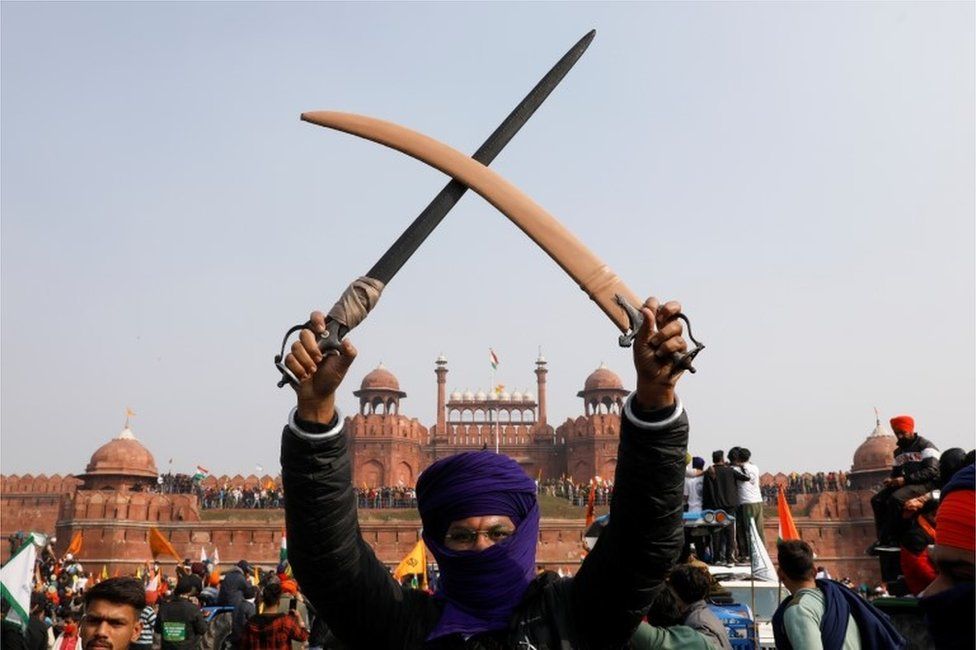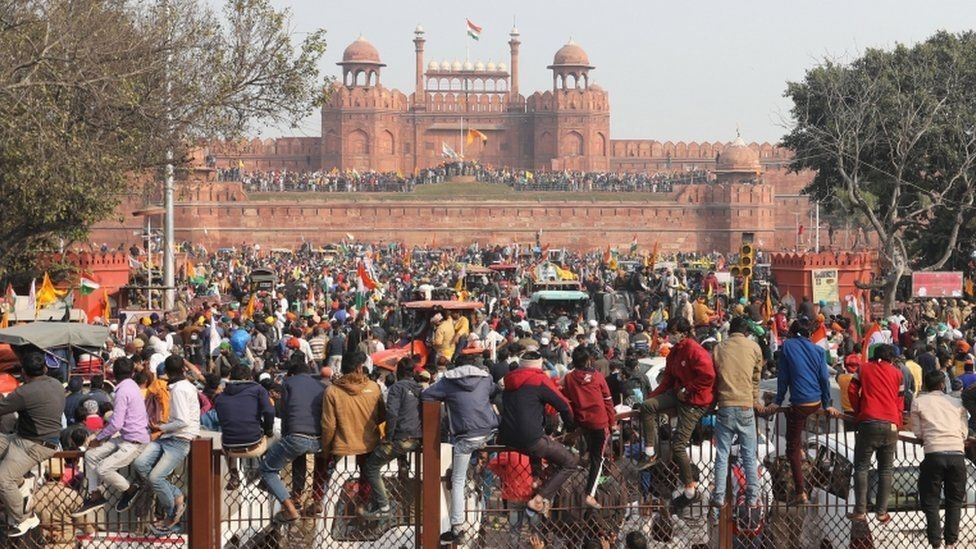
The editorials have been unsparing.
After a rally against farm reforms unexpectedly turned violent on Tuesday, India's farm protests have lost their legitimacy, said one. Accept the government's offer to put the reforms on hold and return home, advised another. Yet another described it as "India's Capitol insurrection" moment.
To be true, a group of protesting farmers did divert from agreed routes, clash with the police and break through barricades to storm Delhi's historic Red Fort complex. One protester died and some 400 policemen were injured.
At the same time, given the scale of the agitation - hundreds of thousands of protesters, many of them riding tractors - the violence could have been much worse. The majority of protesters and the police exercised restraint, with the latter bearing the brunt of the violence. As the protesters called off the rally and dispersed in the evening, traffic gridlocks in the capital eased. Hyperbole and social media outrage apart, India has witnessed far deadlier violent protests in its recent history.
Farm union leaders have condemned the violence and blamed the chaos on rogue elements among an otherwise peaceful march. It is increasingly clear that they might have misread the mood within groups in their fold. The night before the Delhi rally, a bunch of young protesters reportedly took over the stage at a protest site and opposed the routes agreed upon between their leaders and the police. That should have been a warning to the leaders.

Many believe the long-drawn and physically draining protests - hundreds of thousands of farmers camped out in cold and rain for two months, some 60 of them dead so far, and 11 rounds of failed talks with the government - could have resulted in growing frustration in the "young radicals" amongst them. "Maybe the radical approach was finding currency with many followers. The government also allowed the pressure to build up. After the violence the leaders have lost credibility. Their right to represent the farmers will be questioned," KC Singh, a former diplomat, told me.
The farm leaders have said they will isolate the rogue elements. Some of them have alleged that pro-government elements infiltrated Tuesday's demonstration to discredit it. The role of a Punjabi film actor - who campaigned for a Bharatiya Janata Party (BJP) candidate in Punjab - in entering the Red Fort is also being investigated. "The breaching of the Red Fort should be condemned. At the same time, we must uphold the right of farmers to protest," says Pushpinder Singh, a rights activist.
What is clear is that the protesters have lost considerable public goodwill and their leaders have a lot of work to do to restore it. "It has been an orderly, peaceful, lawful protest until now. If some elements have broken the peace and created a situation of anarchy, the leaders will have to do some damage resolution and rise to the challenge," says historian Mahesh Rangarajan.
So what happens next?

One danger is that both sides will become more entrenched in their positions after Tuesday's violence. After multiple rounds of talks and an offer to put the laws on hold for 18 months, the government might well refuse to engage further.
At the same time, it is difficult to see the farmers, mainly from the states of Punjab and Haryana, winding up the protests and returning home in what will then be seen as a defeat of the movement.
On the other hand, the government might use the upcoming federal budget on 1 February to woo the farmers and announce more concessions and schemes for them. As far as the protesters are concerned, opposition politicians have an opportunity to pick up the cudgels for them in parliament. India's opposition have, of late, never missed an opportunity to miss an opportunity.
More negotiations appear to be the only way out of this crippling trust deficit between the two sides. "It is important to keep talking, than not talking. Negotiations take time," Dr Rangarajan says.
Tuesday's violence proves that mass movements need a unified political leader. This agitation has been a "non-party political protest" whose rallying point has not been religion or caste, as is usually the case with agitations in India. It's primarily an "economic movement" by a group of unions against a formidable government led by Prime Minister Narendra Modi's BJP which rules - singly or jointly with partners - in 16 of India's 28 states.
The farmers' agitation is led by dozens of unions of all political persuasions. "Keeping it together for two months has been a miracle. When you have a large following, the following can begin controlling the leadership," Mr Singh says. He believes the protesters need to pipe down, retain the sympathy of the bulk of farmers, call off another planned march to Delhi, meet the government half way and agree to the suspension of the laws. For both the protesters and the government, it has now become an embarrassing stalemate.

Read more by Soutik Biswas

https://ift.tt/2YifJ26
World
Bagikan Berita Ini














0 Response to "India farmers' rally: What's next for the protesters? - BBC News"
Post a Comment